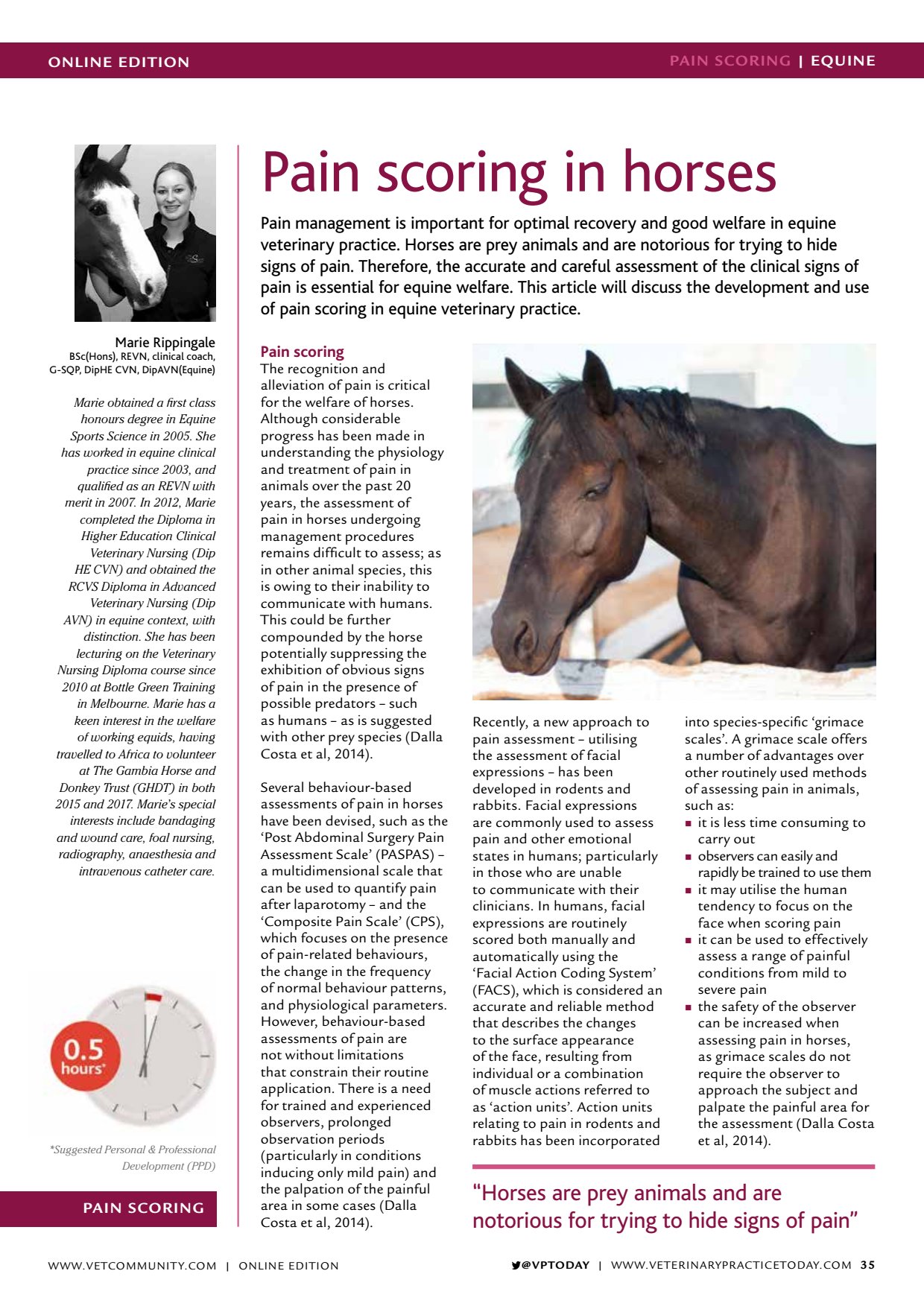Pain scoring horses
ONLINE EDITION PAIN SCORING | EQUINE VPTODAY | WWW.VETERINARYPRACTICETODAY.COM 35 Horses are prey animals and are notorious for trying to hide signs of pain Pain scoring in horses Pain management is important for optimal recovery and good welfare in equine veterinary practice. Horses are prey animals and are notorious for trying to hide signs of pain. Therefore, the accurate and careful assessment of the clinical signs of pain is essential for equine welfare. This article will discuss the development and use of pain scoring in equine veterinary practice. Pain scoring The recognition and alleviation of pain is critical for the welfare of horses. Although considerable progress has been made in understanding the physiology and treatment of pain in animals over the past 20 years, the assessment of pain in horses undergoing management procedures remains difficult to assess; as in other animal species, this is owing to their inability to communicate with humans. This could be further compounded by the horse potentially suppressing the exhibition of obvious signs of pain in the presence of possible predators such as humans as is suggested with other prey species (Dalla Costa et al, 2014). Several behaviour-based assessments of pain in horses have been devised, such as the Post Abdominal Surgery Pain Assessment Scale (PASPAS) a multidimensional scale that can be used to quantify pain after laparotomy and the Composite Pain Scale (CPS), which focuses on the presence of pain-related behaviours, the change in the frequency of normal behaviour patterns, and physiological parameters. However, behaviour-based assessments of pain are not without limitations that constrain their routine application. There is a need for trained and experienced observers, prolonged observation periods (particularly in conditions inducing only mild pain) and the palpation of the painful area in some cases (Dalla Costa et al, 2014). Recently, a new approach to pain assessment utilising the assessment of facial expressions has been developed in rodents and rabbits. Facial expressions are commonly used to assess pain and other emotional states in humans; particularly in those who are unable to communicate with their clinicians. In humans, facial expressions are routinely scored both manually and automatically using the Facial Action Coding System (FACS), which is considered an accurate and reliable method that describes the changes to the surface appearance of the face, resulting from individual or a combination of muscle actions referred to as action units. Action units relating to pain in rodents and rabbits has been incorporated into species-specific grimace scales. A grimace scale offers a number of advantages over other routinely used methods of assessing pain in animals, such as: it is less time consuming to carry out observers can easily and rapidly be trained to use them it may utilise the human tendency to focus on the face when scoring pain it can be used to effectively assess a range of painful conditions from mild to severe pain the safety of the observer can be increased when assessing pain in horses, as grimace scales do not require the observer to approach the subject and palpate the painful area for the assessment (Dalla Costa et al, 2014). Marie Rippingale BSc(Hons), REVN, clinical coach, G-SQP, DipHE CVN, DipAVN(Equine) Marie obtained a first class honours degree in Equine Sports Science in 2005. She has worked in equine clinical practice since 2003, and qualified as an REVN with merit in 2007. In 2012, Marie completed the Diploma in Higher Education Clinical Veterinary Nursing (Dip HE CVN) and obtained the RCVS Diploma in Advanced Veterinary Nursing (Dip AVN) in equine context, with distinction. She has been lecturing on the Veterinary Nursing Diploma course since 2010 at Bottle Green Training in Melbourne. Marie has a keen interest in the welfare of working equids, having travelled to Africa to volunteer at The Gambia Horse and Donkey Trust (GHDT) in both 2015 and 2017. Maries special interests include bandaging and wound care, foal nursing, radiography, anaesthesia and intravenous catheter care. Suggested Personal & Professional Development (PPD) PAIN SCORING WWW.VETCOMMUNIT Y.COM | ONLINE EDITION
